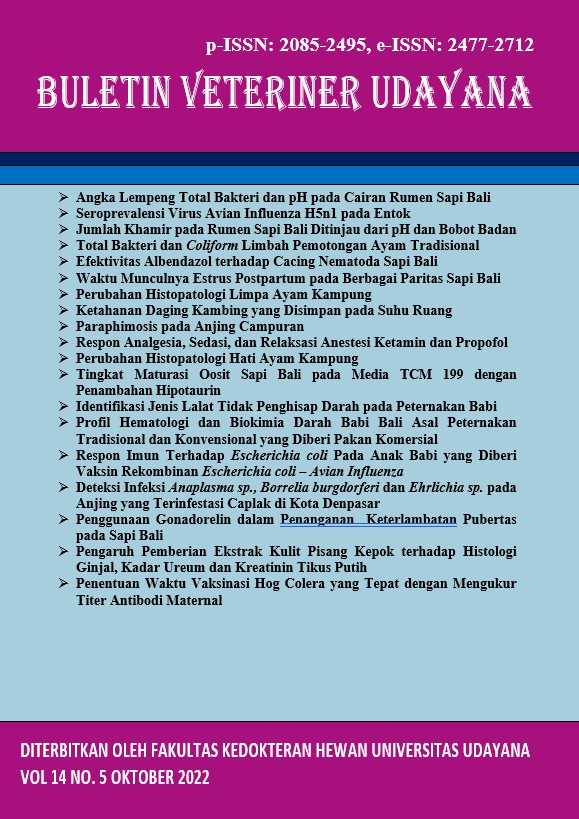TOTAL BACTERIA AND COLIFORM WASTEWATER OF TRADITIONAL CHICKEN SLAUGHTERHOUSE AFTER MORINGA SEED POWDER TREATMENT
Abstract
The waste produced by the traditional chicken slaughterhouse industry consists of two types, namely solid, and liquid waste. The main solid waste consists of feathers, feces and discarded body tissue. The Liquid waste consists of washing water from chicken carcasses mixed with blood, traces of fat, and organic materials. Waste that is directly discharged into waterways without treatment has the potential to contain pathogenic microorganisms. Moringa seeds as natural coagulants contain active compounds amnosyloxy benzyl isothiocynate, tannin polyphenols, and cationic polyelectrolyte proteins. The active ingredient has antiseptic, antibacterial, and coagulation-flocculation activities. This study aims to determine the effect of Moringa seed powder concentration and sedimentation time on total bacteria and Coliforms in traditional chicken slaughterhouse wastewater. Bacterial isolation for the calculation of total bacteria using the pour plate method on the nutrient agar culture, and the total Coliform by the spread plate method on the eosin methylene blue agar culture. The results showed that the coagulation flocculation of Moringa seed powder had a significant effect (P<0.05) on the decrease in total log bacteria and Coliform wastewater of traditional chicken slaughterhouses. It can be concluded that the coagulation-flocculation of Moringa seed powder can decrease the total bacterial and Coliform with the best results at a concentration of 150 mg / L and 60 minutes deposition time.
Downloads
References
Amagloh FK, A. Benang. 2009. Effectiveness of moringa oleifera seed as coagulant for water purification. full length research paper. Af. J. Agric. Res. 4(1): 119-123.
Aini A, M Sriasih, D Kisworo. 2017. Studi pendahuluan cemaran air limbah rumah potong hewan di Kota Mataram. J. Ilmu Lingk. 15(1): 42-48.
Bertus PY, Suherman, Mulyani S. 2014. Karakteristik FTIR poliblend adsorben serbuk biji buah kelor (Moringa oleifera) dan cangkang ayam ras untuk pengolahan air gembut di daerah Palu Barat. J. Akad. Kim. 3(1): 21-29.
Fardiaz S. 1993. Analisis Mikrobiologi Pangan. Raja Grafinda Persada: Jakarta.
Goyal BR, BB Agrawal, RK Goyal, AA Mehta. 2007, Phytopharmacology of Moringa oleifera Lamk. An overview. Nat. Prod. Radiance. 6(4): 347-353.
Januardi R, Aditiya A, Andriani S. 2014. Pengolahan limbah cair tahu menggunakan kombinasi serbuk kelor (Moringa oleifera) dan asam jawa (Tamarindus indica). Protobiont. 3(1): 41-45.
Kusnaedi. 2002. Mengolah Air Gambut dan Air Kotor untuk Air Minum. Cetakan Kesembilan, PT. Penebar Swadaya. Jakarta
Mahendra MS, Suyasa IWB, Nuarsa IW, As-syukur AR, Ernawati NM, Ardiswana IPA, Karsika IM. 2015. Kajian Kualitas Perairan Tukad Badung di Kota Denpasar, Bali. Laporan Penelitian Program Studi Magister Ilmu Lingkungan Universitas Udayana. https://repositori.unud.ac.id/protected/storage/upload/. Akses 2 Agustus 2019.
Marlina N, Hudori, Hafidh R. 2017. Pengaruh kekasaran saluran dan suhu air pada parameter kualitas air cod, TSS di sungai winongo menggunakan software Qual2Kw. J. Sains Teknol. Lingk. 9(2): 122-133.
Nand V, M Maata, K Khosy, S Shotteswaran. 2012. Water purification using moringa oleifera and other locally available seeds in fiji for heavy metal removal. Int J. Appl. Sci. Tech. 2(5): 125-129.
Napoleon P, J Anitha, RR Emilin. 2009. Isolation, analysis and identification of phytochemicals of antimicrobial activity of Moringa oleifera Lam. Cur. Biotica. 3(1): 33-37.
Oludoro AO, BI Aderiye. 2007. Efficay of Moringa oleifera Seed Extract on the Microflora of Surface and Underground Water. Departement of Microbiology, University of Ado-Ekiti, Ado-Ekiti, Nigeria.
Pritchard MT, T Craven, AS Mkandawire, JG Edmonson, O’Neill. 2010. A study of the parameters affecting the effectiveness of moringa oleifera in drinking water purification. J. Physics Chem. Earth. 35(13): 791-797.
Ritwan. 2004. Biji Kelor Penjernih Air. http://www.rri-online.com/modules. Akses 20 Juli 2019.
Sari RK, L Tina, AF Fachlevy. 2017. Efektifitas biji kelor (Moringa oleifera) terhadap bakteri escherichia coli dalam upaya pencegahan penyakit diare. JIMKESMAS. 2(6): 1-8.
Sari RA, JA Pinem, S Daud. 2016. Pemanfaatan biji kelor (Moringa oleifera) sebagai koagulan pada pengolahan air payau menjadi air minum menggunakan proses koagulasi ultrafiltrasi. J. FTEKNIK. 3(1): 1-7.
Schwarz D. 2000. Water Clarificatiom Using Moringa oleifera. Technical Information Wle, Gate Information Service, Eschborn, Germany. http://www.gtz.de/gate/gateid.afp.
Singgih ML, K Kariana. 2010. Peningkatan produktivitas dan kinerja lingkungan dengan pendekatan green productivity pada rumah pemotongan ayam. J. Purifikasi. 9(2): 137-146.
Suharto. 2010. Limbah Kimia Dalam Pencemaran Air dan Udara. Andi, Yogyakarta.
Wibawarto DK, Syafrudin, WD Nugraha. 2017. Study Penurunan Turbidity, TSS, COD Menggunakan biji kelor (Moringa oleifera) sebagai nanobiokoagulan dalam pengolahan air limbah domestik (Grey Water). J. Tek. Lingkungan. 6(1): 1-6.
Widya N, W Budiarsa, MS Mahendra. 2010. Studi pengaruh air limbah pemotongan hewan dan unggas terhadap kualitas airsungai Subak Pakel I Di Desa Darmasaba Kecamatan Abiansemal Kabupaten Badung. Ecotrophic. 3(2): 55-60.





